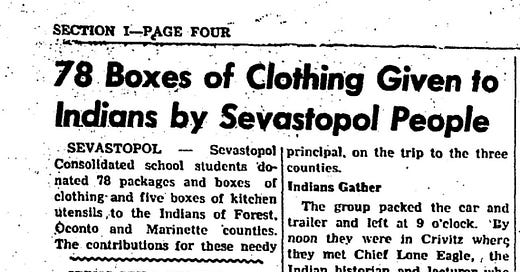“Indian Chief at Sevastopol Club” and “78 Boxes of Clothing Given to Indians by Sevastopol People” from the 1949 Door County Advocate
[October 4, 1949]
Indian Chief at Sevastopol Club
Community Group to Name Officers and Have Lunch Room Shower Thursday
SEVASTOPOL — Chief Lone Eagle, a traveling Indian historian, trader and lecturer, will entertain members of the Sevastopol Community club this week Thursday evening with an interesting program. The Indian chief carries with him a museum of Indian relics which will be on display.
The first community club meeting will open with a business meeting at 8 o’clock at the Sevastopol High school. Election of officers will be held. The present officers of the group are Mrs. Lloyd Wagner, president Mrs. Edwin Ash, vice-president, and Donald Mann, secretary.
Lunch Room Shower
Also featured at the meeting will be a shower for the lunch room. Those attending will bring gifts for the hot lunch program as has been customary in the past.
Chief Lone Eagle, who will present a program for the students during the day, has among his museum relics the chest given to Chief Tecumseh by the French to hold the Indian-French treaty regarding colonial settlers. Also shown will be an assortment of war clubs and drums, and an Indian medicine chest, some which were carried in the Black Hawk war.
[November 29, 1949]
78 Boxes of Clothing Given to Indians by Sevastopol People
SEVASTOPOL — Sevastopol Consolidated school students donated 78 packages and boxes of clothing and five boxes of kitchen utensils to the Indians of Forest, Oconto and Marinette counties. The contributions for these needy
﹏﹏﹏﹏﹏﹏﹏﹏﹏﹏﹏
ITEMS STILL NEEDED
Despite the generous contributions by the people of the Sevastopol area, a few people did not receive all the clothing they needed. Among the things still needed are two large sweaters, size 42 to 46; a light overcoat or jacket, size 36–40; men’s shoes or oxfords, size 8-9-10; lumberjack rubbers, size 9 or 10, and men’s suits, size 26–42, and jackets or overcoats of the same size. If these articles are mailed or taken to the Sevastopol school, they will be forwarded to the Indians who need them.
﹏﹏﹏﹏﹏﹏﹏﹏﹏﹏﹏
individuals were made by the students and faculty of the Sevastopol school and by the people who live in the area served by the school.
In order to make a learning exercise of the project, the student body of the high school elected Henry Spille Jr. and William DeFaut to accompany C. A. Krohn, principal, on the trip to the three counties.
Indians Gather
The group packed the car and trailer and left at 9 o’clock. By noon they were in Crivitz where they met Chief Lone Eagle, the Indian historian and lecturer who appeared at the Sevastopol school in October. Lone Eagle had written ahead to Chief Thunder, the ruling chief of the tribe, and had the Indians gathered at three places to meet the people from Door county.
The first stop was made just outside of Soperton in a spot of cutover land. Twelve Indians lived in a 16 x 20 foot cabin, where there was no furniture except a built-in bunk, a table and two fruit boxes for chairs. Despite the lack of any evident water supply, the house was fairly clean. This could not be said of some of the other places visited, according to the group. Four boxes of clothing and one of dishes were left here.
See Medicine Man
Next the group visited the medicine man of the tribe. To get to his house the Sevastopol three had to travel a half mile on a dirt road that was slippery and full of potholes. At this house five Indians were waiting, and overcoats, sweaters and considerable children’s clothing were left.
One couple had walked five miles through the woods to get this clothing, and they had to pack the clothing on their backs for the return trip. Despite the wet and cold, the Indian woman who had walked the five miles wore tennis shoes. She was given overshoes, shoes and wool stockings in addition to the other clothing.
More Than 50 Assemble
In Soperton, the next stop, more than 50 Indians had gathered at the Indian hall to await the arrival of the Sevastopol items. Children of all ages and sizes were fitted. Overshoes, suits, caps, ties, dresses, sweaters, and underwear were selected by those present.
Not only were the Indians able to pick things for themselves but they could also choose items for their neighbors and friends who were not present.
“Nothing is wasted, and every piece of cloth is used,” according to Mr. Krohn. If one person of the group had two caps, he would give one to someone else.
Walked 32 Miles
One family present at Soperton had walked 32 miles to be there because the children needed winter clothes for school. Every child’s winter dress or sweater was measured on the husband — he must have been more the size of the children than his wife.
A blind couple, both about 60, were present, and they were fitted with clothing before any of the others would accept any clothing that might fit “Grandmother” and “Grandfather.” This old couple was unable to care for themselves, and, although they were no relation to one family, this family adopted them.
17 in One House
The last stop was made on the return from Soperton and four boxes, largely baby clothes, were left. In this house, 14 x 18 feet, 17 people were living, four of whom were babies.
The house was dirty and without any furniture except for an old davenport. There were no chairs or beds, and all the inhabitants slept on blankets on the floor. One shelf held a few bowls but no dishes.
The students who made the trip gave a report to their classes in school.
Both courtesy of the Door County Library Newspaper Archive
Posts relating to Native Americans
https://doorcounty.substack.com/t/native-americans




